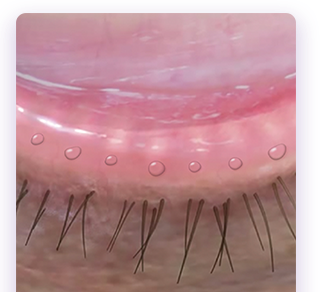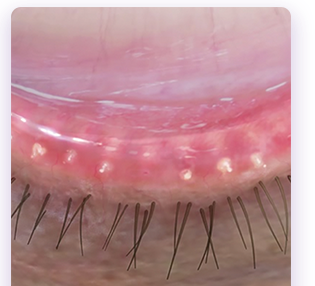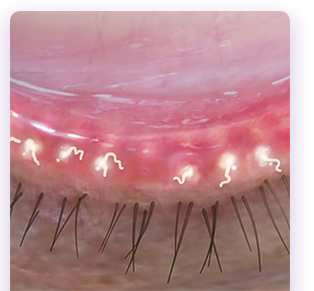
Dry Eye Syndrome
Are you tired of struggling with dry, irritated, or watery eyes? The dry eye specialists at San Francisco Eye Institute offer a range of non-surgical treatment options for patients suffering from dry eye symptoms, including iLux.
Book an AppointmentWhat is Dry Eye Syndrome?
Dry eye syndrome, also referred to as dry eye disease, is a lack of proper lubrication in the eyes and is caused by issues within the tear film. When we blink, tear film moisturizes the eye and washes away debris. Tear film also helps prevent eye infections and keep vision clear. Tear film issues may be caused by inadequate production of tears to lubricate the eyes, tears that are of poor quality, or tears that lack sufficient oil. Symptoms of dry eye syndrome may include:
- Burning eyes
- Irritation, stinging, or discomfort
- Watery eyes
- Blurred vision
- Eye fatigue
- Difficulty with night vision
- Difficulty wearing contact lenses
- The feeling that there is something in the eyes
- Mucus on or around the eyes
- Redness
- Light sensitivity
- A feeling of grittiness1
Types of Dry Eye
Aqueous Deficient Dry Eye
Aqueous deficient dry eye is caused by insufficient production of tears. This may be caused by age, medical conditions, medications, or a lack of sensitivity of the corneal nerve.
Evaporative Dry Eye
Evaporative dry eye is the more common type of dry eye disease, and is the result of increased tear evaporation. The most frequent cause of evaporative dry eye disease is Meibomian Gland Dysfunction, but it may also be caused by allergies, problems with the eyelids, blinking less often, or environmental factors.
What is Meibomian Gland Dysfunction (MGD)?
Moisture is essential to healthy eyes. Each time you blink your eyes, a tear film that contains an oil called meibum is distributed on the surface of your eye. The part of your eyes that produces meibum are your meibomian glands. Meibomian Gland Dysfunction, or MGD, is a common eye condition that happens when the meibomian glands do not work properly, usually because they are blocked. More than 85% of people with dry eye symptoms may be suffering from MGD.2

Healthy Meibomian Glands

Meibomian Glands With Moderate MGD

Meibomian Glands With Severe MGD
Additional Causes of Dry Eye
Meibomian Gland Dysfunction is the main cause of dry eye syndrome, but there may be other causes or contributing factors:
- Age
- Extensive screen time
- Prolonged sun exposure
- Hormone imbalances or changes
- Medications
- Medical conditions

Home Remedies for Dry Eye
There are some steps you can take at home to alleviate symptoms of dry eyes, including:
- Warm Compress: Place a warm compress, such as the Ocusoft Dry Eye Mask, over closed eyelids for roughly 15 minutes. This can help break up minor meibomian gland blockages and initiate tear production.
- Environmental Factors: Some of your daily activities or factors in your environment may be contributing to your dry eye symptoms. For example, if you spend a lot of time staring at a computer screen, this may dry your eyes. Try taking more breaks or wearing glare-protection glasses. You may also consider moving out of the flow of a fan or using a humidifier.
- Artificial Tears: Over-the-counter moisturizing eye drops can provide temporary relief for symptoms of dry eye disease. Be sure to purchase eye drops designed to lubricate, not just treat redness.
- Vitamins and Supplements: A diet rich in omega-3 fatty acids may help with tear production. Supplements designed for eye health may also help with dry eye symptoms.
Professional Treatment for Dry Eye
For patients who do not find adequate relief from dry eye symptoms using at-home or over-the-counter remedies, we offer effective treatment for dry eye, including:
- Tear ointments/gels
- Prescription eye drops
- Punctal plugs
- Meibomian expression – iLux
We offer meibomian expression using iLux, an FDA-approved device that uses gentle heat and pressure to soften oil buildup and unblock meibomian glands in order to alleviate dry eye symptoms. iLux is clinically proven to significantly increase meibomian gland function and deliver substantial improvement in irritating dry eye symptoms.3
iLux Treatment: What to Expect
Before Your Treatment
If you have dry eye symptoms, such as itchy, red, watery, or gritty-feeling eyes, the first step is a consultation appointment at our San Francisco office. One of our experienced eye doctors will assess your eyes to determine if MGD could be causing your symptoms and if you are a candidate for iLux.
During Your Treatment
Your eye doctor will position the iLux device over your eyelid. You will feel a warm sensation as the therapeutic heat works to unblock the meibomian glands. Your eye doctor will then use gentle compression to remove excess oil from the glands. Many patients say that iLux treatment feels like a warm massage. The procedure typically takes less than 15 minutes.
After Your Treatment
iLux is non-surgical and non-invasive and there is no recovery time needed after treatment. Your dry eye symptoms will continue to improve in the weeks after treatment as your meibomian gland function improves.
Frequently Asked Questions About iLux
Is there a cure for dry eye syndrome?
There is no way to permanently cure dry eye syndrome, but there are many ways to effectively manage symptoms of dry eye for long-term relief.
Can I prevent dry eye syndrome?
Dry eye syndrome can’t always be prevented, as it is caused by a variety of factors. Still, you can make certain lifestyle changes that may help prevent dry eye symptoms, including:
- Get plenty of sleep
- Eat a nutritious diet with Vitamin A and Omega-3 fatty acids
- Drink at least eight glasses of water each day
- Avoid smoking and secondhand smoke
Do I need to stop home treatments when using iLux?
No, you can still use at-home dry eye treatments while undergoing iLux treatment. While you may see a significant improvement in dry eye symptoms after your first iLux treatment, sometimes optimal results take two to four weeks. During that time, using warm compresses, artificial tears, and even prescription eye drops can be helpful.
How often do I need to have iLux treatment?
Most of our patients see a significant improvement in dry eye symptoms after their first iLux treatment, and results only get better over the following two to four weeks. Patients experience symptom relief for up to six to eight months, at which time they may wish to come in for another iLux treatment session.
Does iLux hurt?
Treatment with iLux does not hurt at all. Patients simply relax while the thermal pulsation device delivers gentle warming pressure for an 8-15 minute treatment session. Most of our patients report that treatment with iLux actually feels good.
Does insurance cover dry eye treatment?
Some dry eye treatments may be covered by medical insurance, but not all. For example, iLux treatment is not eligible for insurance coverage. However, we do offer a variety of payment options to make it easier for our patients to afford dry eye treatment.
Contact San Francisco Eye Institute for Dry Eye Treatment
You don’t have to live with the discomfort and irritation of persistent dry eyes! If you’re seeking a simple and effective solution to dry eye symptoms, iLux may be right for you. Contact us today with any questions or to schedule your consultation appointment.
4.7/5 Average Rating based on over 240 reviews
1 Mayo Clinic. Dry Eyes. Available: https://www.mayoclinic.org/diseases-conditions/dry-eyes/symptoms-causes/syc-20371863. Accessed May 2, 2022.
2 Lemp MA, Crews LA, Bron AJ, Foulks GN, Sullivan BD. Distribution of aqueous-deficient and evaporative dry eye in a clinic-based patient cohort: a retrospective study. Cornea. 2012;31(5):472–478. doi:10.1097/ICO.0b013e318225415a.
3 Tauber J, Owen J, Bloomenstein M, Hovanesian J, Bullimore MA. Comparison of the iLUX and the LipiFlow for the Treatment of Meibomian Gland Dysfunction and Symptoms: A Randomized Clinical Trial. Clin Ophthalmol. 2020;14:405-418
Page Updated:
The doctors at San Francisco Eye Institute have either authored or reviewed and approved this content.
Ensuring the highest level of vision care and individual attention possible.
Whether you just need a general eye exam, or if you are interested in reducing or eliminating your need for glasses or contacts, our team is here to help! Contact us to book an appointment today!

